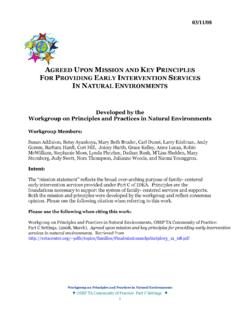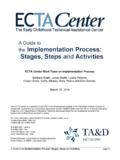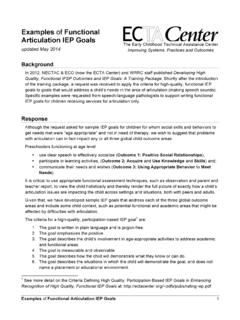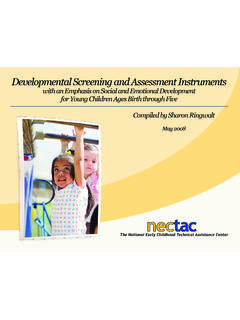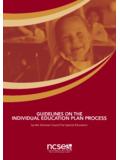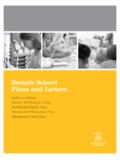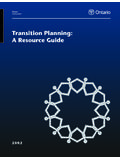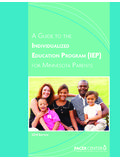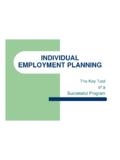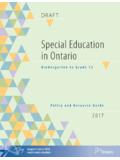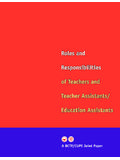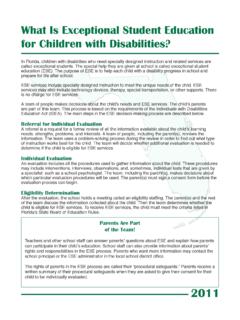Transcription of Individualized Education Program (IEP) - …
1 Essential Early Education Vermont Department of Education IEP ~ Ages 3 through 5. Individualized Education Program (IEP). School District: Some School District Annual Meeting Date: 05/19/2012. IEP Case Manager: Casey Manager Next Annual Review Date: 05/19/2013. Next 3-year Re-evaluation Date: 02-10-2014 Effective date of Revision : 09/01/2012. Child's Name: Amanda Date of Birth: May 29th 2009. Disability Category: Developmental Delay Child Count ID #: 123456. School or Program : Awesome Early Childhood Program Grade Assigned: EE. Parent/Guardian: Amanda's Mom and Dad Telephone #: (802)555-5555. Address: Your town Initiation and Duration of the IEP: Initiation and Duration of Extended Year Services: 05/29/2012 to 06/15/2012 07/10/2012 to 08/10/2012. 09/01/2012 to 05/29/2013. IEP Team Members Printed Name/Position/Agency (check box if in attendance).
2 Name: Amanda's Mom and Dad Parent(s)/Guardian/Educational Surrogate (circle one). Name: Amanda Child (when appropriate). Name: Al Covered Local Education Agency (LEA) Representative Name: Olive Myjob Special Education Teacher or Service Provider Name: Idu Tue Early Childhood Education Teacher Individual who can interpret the instructional Name: Tess Ting (SLP) implications of evaluation results Other: Physical Therapist Name: Latisha Dorsi Others with knowledge of the child* Position/Agency/Community-based Childcare Setting Name: Ima Smiley Lead Teacher-Community-based Childcare Program Name: Name: *With parental consent, include individuals from CIS/Early Intervention if child is transitioning from EI services to EEE at age 3. Transition from Part C to Part B Data Collection Only complete this section for children who have received Part C CIS/EI services and are eligible for Part B EEE services at age 3.
3 Action Date written notification from Part C Transition Meeting Held Late Referral Notification Date IEP was Parental consent was (CIS/EI)was received in district >90 days prior to 3rd B-day <90 days prior to 3rd B-day developed received (Form 6). Date Completed 10/19/2011 02/19/2012 n/a 05/19/2012 05/19/2012. Form 5: VT DOE EEE IEP July 1, 2012. Essential Early Education Vermont Department of Education IEP ~ Ages 3 through 5. Individualized Education Program Present Levels of Educational and Functional Performance Child's Name: Amanda IEP Meeting Date: 05/19/2012. This section should provide a concise overview of the child's current skills and serve as the basis of the child's Program planning and service delivery for the upcoming year. Describe the child's present levels of development across each global outcome area including functional performance, abilities, acquired skills and strengths relative to the Vermont Early Learning Standards and/or developmentally appropriate expectations.
4 As appropriate, address the following areas: Briefly describe the child, his/her interests, and how the child's developmental delay or medical condition affects his/her access to and participation in age appropriate activities. As a toddler, Amanda received early intervention services for through the local Part C Children s Integrated Services/Early Intervention agency to address communication and motor needs. She transitioned to school based services in May (2012). At that time, Amanda received home-based services 2 x per week as well as itinerant special Education services at a community- based childcare 2 x per week. In June (2012), Amanda was diagnosed with Pervasive Developmental Disorder-not otherwise specified (PDD-NOS). She was years of age at the time of diagnosis. Currently, Amanda attends and receives special Education and related services in the school district s early childhood classroom 3 days per week for 4 hours per day.
5 She also attends a community-based childcare Program 2 full days per week. Amanda has limited eye contact yet tends to use her peripheral vision when attending She will observe her peers from a distance. She is just beginning to initiate interaction with her peers She has been observed imitating her peers actions along with some words (vocal imitation is increasing). Amanda demonstrates a limited range of emotions in play Playing in closer proximity of her peers, Amanda requires an adult to facilitate peer play opportunities such as sharing or trading toys/materials. Amanda s receptive language skills are more age appropriate than her expressive language skills Amanda will use signs (more, help, stop, please) on occasion to help her communicate Adults and peers have increased their use of ASL in some routines/settings MEDICAL History: (physical, hearing, vision, CDC report, etc.)
6 Briefly describe how the child s disability or medical condition affects his/her access to and participation in age appropriate activities. Diagnosed with PDD-NOS (June 2012). Amanda s hearing was tested in June of 2012 and results were within normal range Amanda has mild to moderate pronation in both feet. She recently has been fitted with orthotics (dafos) to support her mobility, coordination, stability and balance. Amanda s most recent medical examination (July 2012) report stated that she was in good health for her age. No health concerns at this time but physician will receive progress reports from physical therapist on a monthly basis Child STRENGTHS: Consider child s strengths across the three early childhood outcome (ECO) areas: A. Social emotional skills and relationship: She has been observed imitating her peers actions along with some sounds (vocal imitation is increasing).
7 B. Acquisition and use of knowledge and skills: She is a sweet and loving girl who smiles when she is drawing, using scissors to snip and actively engaged in art activities-especially when she has the opportunity to use glue Amanda uses 1-word signs (ASL) such as more , help , stop , please . She is curious about but may perseverate on mechanical items (cd player, radio in car, wind-up toys, items with an on/off switch). She is pointing to some of her favorite pictures in storybooks Amanda will attend to 1 or 2 books at a time given caregiver support at preschool and at home C. Taking action to meet needs: Amanda seeks out books from the book basket in the classroom and at home and will retrieve a book, bring it to an adult, and tug on the adults clothing to gain their attention Amanda is using picture cards at home to support transition times and meal times Amanda uses 1-word signs (ASL) such as more , help , stop , please.
8 Form 5: VT DOE EEE IEP July 1, 2012. Vermont Department of Education Child CONCERNS: Consider child s concerns across the three early childhood outcome (ECO) areas: A. Social emotional skills and relationship: If behavior is a concern, has a functional behavior assessment been considered and/or conducted?*. Amanda has a difficult time maintaining engagement with adults, peers and objects for more than 2 minutes. Amanda uses gestures paired with vocalizations in 25% or less of her communications with adults and peers Amanda demonstrates a limited range of emotions in play B. Acquisition and use of knowledge and skills: Amanda will respond to and follow a one-step direction , put cup here but has difficulty with responding and following through when given a two- step direction When asked to identify specific objects, people, symbols/pictures, Amanda may point to a few correctly but not all.
9 Her response is inconsistent across adults, settings, materials. C. Taking action to meet needs: Limited mobility and communication affects Amanda s participation and engagement with peers across daily routines and activities. Amanda uses one-word/action signs (ASL) , more , help , stop , please however, her use of signs is inconsistent across daily routines and adults Child NEEDS: (consider and prioritize the necessary supports that adults need to incorporate in order for the child to access and participate in age appropriate activities within a regular early childhood setting with his/her same-age peers and/or within their home environment.). A. Social emotional skills and relationship: If behavior is a concern, is an FBA intervention plan needed?* not needed at this time Amanda s communication and engagement with peers and adults is limited.
10 It is recommended that daily semi- structured play sessions are developed and implemented to increase the number of opportunities Amanda has to increase back n forth interactions to prolong her play and engagement with adults, peers, and toys across daily routines and activities. B. Acquisition and use of knowledge and skills: Increase use of ASL during activities and tasks is highly recommended. Amanda will benefit from embedded learning opportunities within the regular early childhood curriculum C. Taking action to meet needs: Amanda has most recently been fitted with Dafos to improve her stability for successful standing, walking and keeping up with her peers. Implement daily recommendations by physical therapist. Increase use of ASL throughout daily routines is highly recommended. OTHER CONSIDERATIONS: (safety/health; school district partnerships with community-based early childhood programs (Act 62); functional behavior assessment (FBA)*; private early childhood programs ; home-visiting; community-based child and family resources (Children s Integrated Services.))
